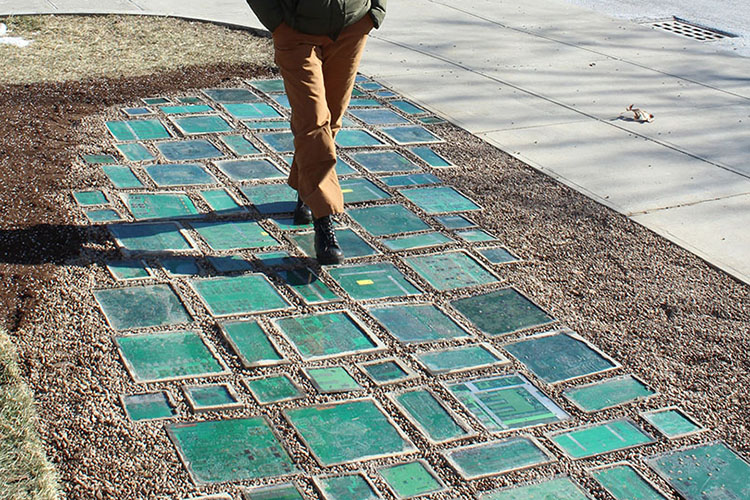
“Circuit Boardwalk” features 200 square feet of tiles made primarily of discarded circuit boards and concrete composed almost entirely of recycled materials. (Photo courtesy of Nathaniel Stern)
Unusual walkway tiles created at UW-Milwaukee using 95% recycled materials now form an inspiring path in front of the engineering building at a New York university: a pedestrian stroll that spotlights problems inherent in electronic and construction waste.
Binghamton University Art Museum commissioned Nathaniel Stern, professor of art and mechanical engineering at UWM, to create a long-term installation that calls attention to personal, institutional and governmental accountability in the production and disposal associated with technology and industry.
The result, installed in January, is “Circuit Boardwalk” – 200 square feet of tiles made primarily of discarded circuit boards and concrete composed almost entirely of recycled materials. The concrete was made in UWM’s Advanced and Nano Cement Laboratory under the direction of Konstantin Sobolev, Lawrence E. Sivak ’71 Faculty Fellow and professor of civil and environmental engineering.
With their emerald-green color, the tiles invite pedestrians to walk on them. When they do, they see the fine details of a printed circuit board – copper, gold and palladium – embedded in concrete and protected by a thin layer of resin.
Inspiring students to rethink waste, responsibility
In January, Stern and Sobolev attended the exhibition, installation and panel discussion at Binghamton University.
“It was a highlight of my career,” Stern said.
“The dialogue between art and science, between inspiring action and change, and the technologies to do so, are key in the design of our futures,” he said. “We need to think about what we can do and change, individually, about the systems that create waste and our influence on them, and about new potentials and possibilities in both of those spaces.”
Each square tile – 1½ inches thick and of various widths – was created at UWM in Stern’s studio and Sobolev’s concrete lab.
To make them, Stern started with recovering circuit boards from trashed computers that were decommissioned and ready for recycling at UWM Surplus.
Sobolev, with his students, then created a concrete base composed of recycled materials left over from multiple research projects that otherwise would have been sent to landfill.
“Cement and concrete are the world’s most widely used construction materials,” said Sobolev, a recognized expert in innovative concrete materials. “The most promising research in the field today addresses the recyclability of concrete and reducing its carbon footprint.”
To this end, Sobolev is leading efforts to launch a National Science Foundation Concrete Advancement Network, in tandem with Arizona State University, Oregon State University and the University of Texas at Arlington, to tackle these very issues in collaboration with industry.
14 UWM students helped create project
Fourteen UWM students from three UWM colleges/schools worked with Stern and Sobolev as project assistants on “Circuit Boardwalk.” The students’ work – their research contributions and travel to Binghamton – was supported by UWM’s Office of Undergraduate Research, which fosters faculty-student research across campus.
From Peck School of the Arts: Meghan Berger, Laura Bogyay, Mich Dillon and Mary Widener.
From the College of Engineering & Applied Science: Aparna Deshmukh, Behrooz Farahi, Paul George, Reed Heintzkill, Garrett Kocourek, Roy Wittenberg and Filip Zemajtis.
From the College of Letters & Science: Allison Getty, Ava Ladky and Madison Sveum.
“With the worsening state of the climate, it’s increasingly important to emblemize the problem of waste in a variety of ways,” said Kocourek, a senior in mechanical engineering.
His generation of engineers, Kocourek believes, must consider sustainability in all their work. “It will become a design constraint as we work to eliminate our dependence on fossil fuels and combat material shortages.”
Written by Carolyn Bucior
Link to original story: https://uwm.edu/news/walkway-installation-spotlights-the-problem-of-electronic-and-construction-waste/
